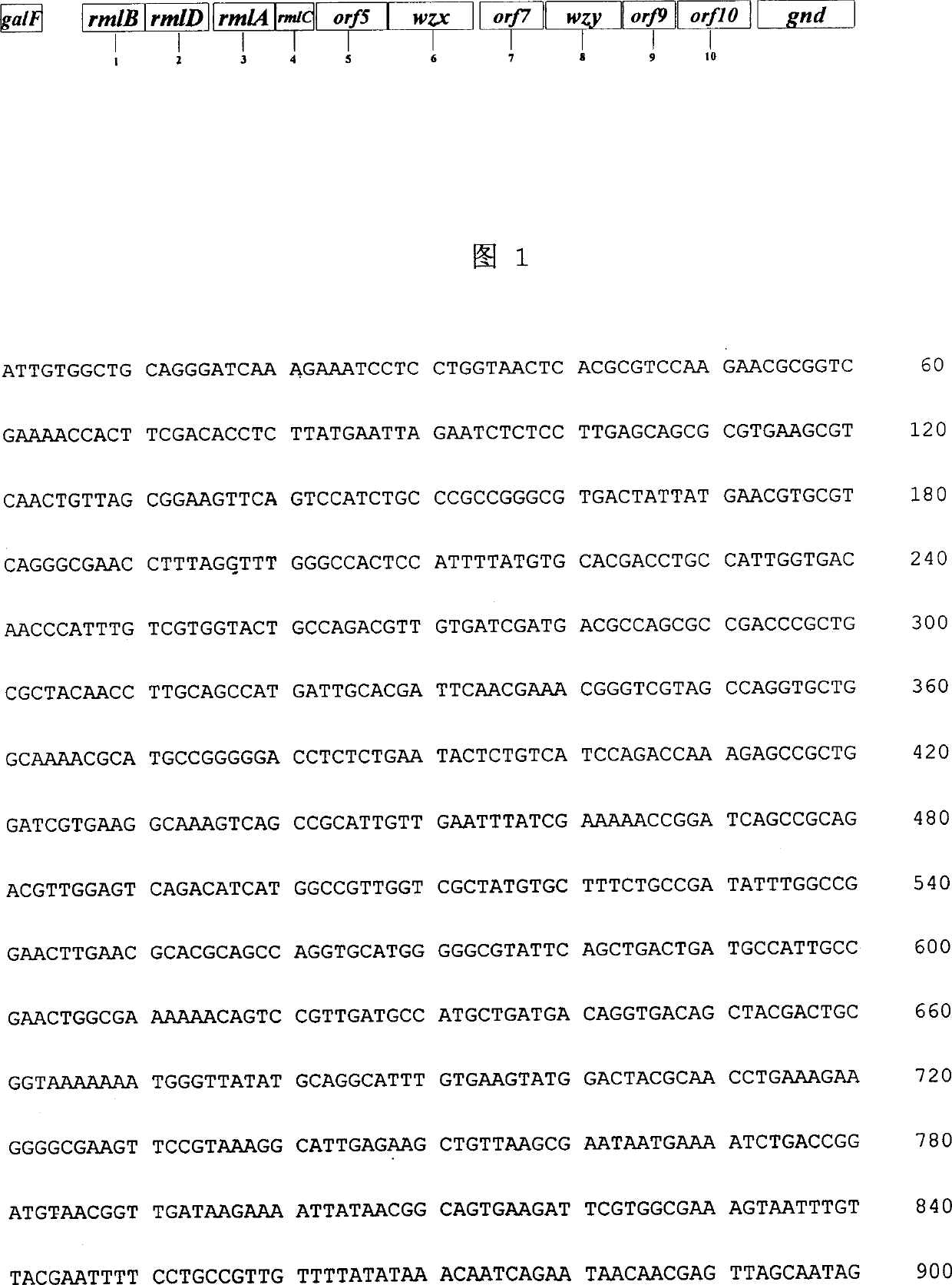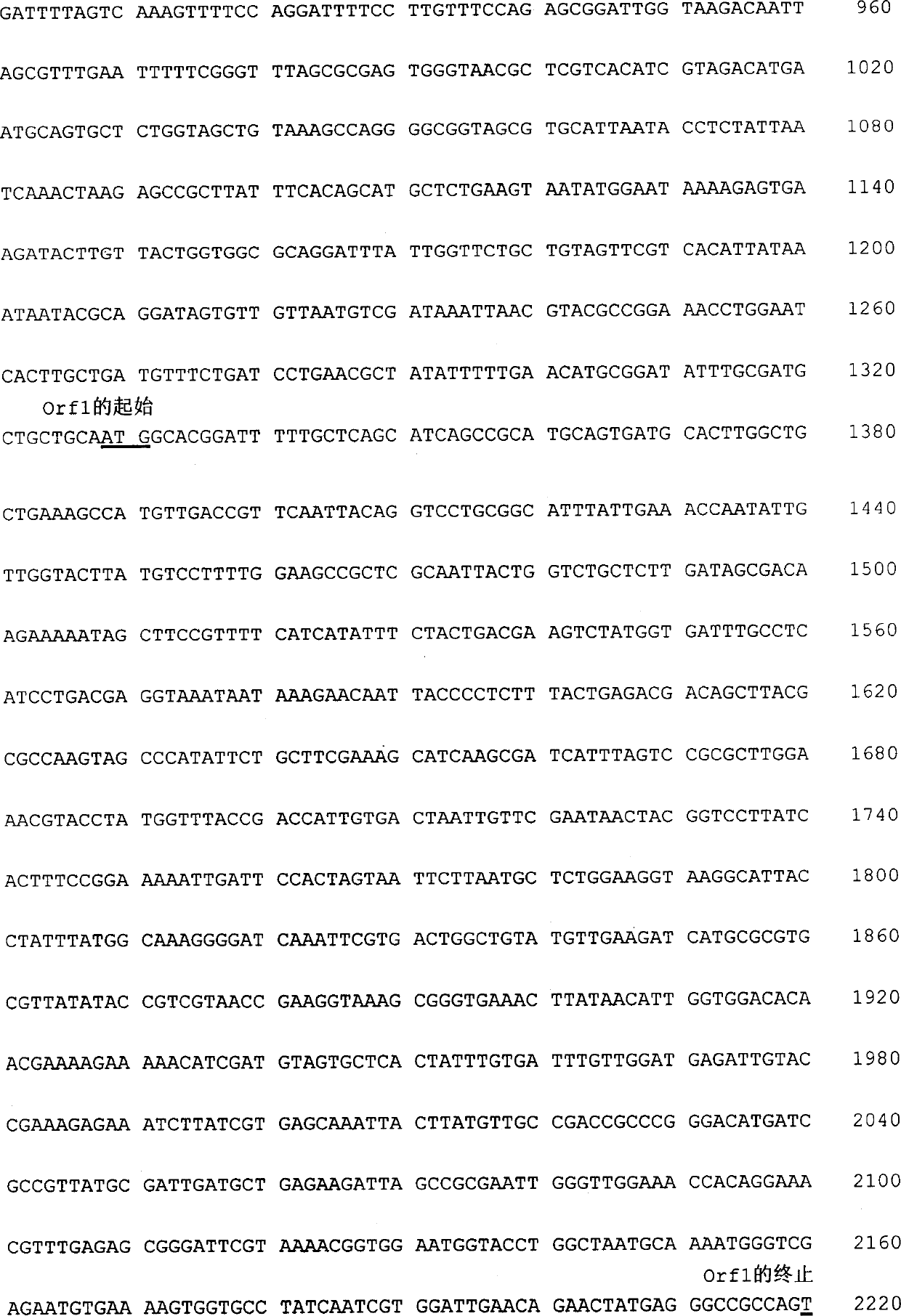Nucleotide with specificity to o-antigen of type-12 shigella shigae and colibacillus 0152
A technology of Shigella dysenteriae and Escherichia coli, applied in the field of nucleotides specific to the O-antigen of Shigella dysenteriae type 12 and Escherichia coli O152, which can solve the problems of indistinguishability
- Summary
- Abstract
- Description
- Claims
- Application Information
AI Technical Summary
Problems solved by technology
Method used
Image
Examples
Embodiment 1
[0030] Shigella was cultured overnight at 37°C in 5 mL of LB medium, and the cells were collected by centrifugation. The cells were resuspended with 500ul 50mM Tris-HCl (pH8.0) and 10ul 0.4M EDTA, incubated at 37°C for 20 minutes, and then 10ul 10mg / ml lysozyme was added to continue the incubation for 20 minutes. Then add 3ul 20mg / ml proteinase K, 15ul 10% SDS, incubate at 50°C for 2 hours, then add 3ul 10mg / ml RNase, 65°C for 30 minutes. Add an equal volume of phenol to extract the mixture, take the supernatant and extract twice with an equal volume of phenol:chloroform:isoamyl alcohol, and extract the supernatant with an equal volume of ether to remove residual phenol. The DNA was precipitated with 2 times the volume of ethanol in the supernatant, and the DNA was rolled out with glass wool and washed with 70% ethanol, and finally the DNA was resuspended in 30ul TE. Genomic DNA was detected by 0.4% agarose gel electrophoresis. Example 2: Amplification of the O-antigen gene ...
Embodiment 2
[0031] The O-antigen gene cluster of Shigella dysenteriae type 12 was amplified by Long PCR. First, design the upstream primer (#1523-ATT GTG GCT GCA GGGATC AAA GAA AT) based on the JumpStart sequence often found in the promoter region of the O-antigen gene cluster, and then design the downstream primer (#1524 -TAGTCG CGT GNG CCT GGA TTA AGT TCG C). Use the ExpandLong Template PCR method of Boehringer Mannheim to amplify the O-antigen gene cluster. The PCR reaction program is as follows: pre-denaturation at 94°C for 2 minutes; then denaturation at 94°C for 10 seconds, annealing at 60°C for 30 seconds, and extension at 68°C for 15 minutes. Do 30 cycles. Finally, continue extending at 68° C. for 7 minutes to obtain PCR products, and use 0.8% agarose gel electrophoresis to detect the size and specificity of the PCR products. Combine 6 tubes of long PCR products, and use Promega's Wizard PCR Preps purification kit to purify the PCR products. Embodiment 3: Construction of O-anti...
Embodiment 3
[0032] A modified Novagen DNaseI shot gun method was used to construct the O-antigen gene cluster library. The reaction system is 300ng PCR purified product, 0.9ul 0.1M MnCl 2 , 1 ul of 1 mg / ml DNaseI diluted 1:2000, and the reaction was carried out at room temperature. Digest for 10 minutes to concentrate the DNA fragment size between 1kb-3kb, then add 2ul 0.1M EDTA to terminate the reaction. Combine 4 tubes of the same reaction system, extract once with an equal volume of phenol, once with an equal volume of phenol:chloroform:isoamyl alcohol (25:24:1), and then once with an equal volume of diethyl ether. Precipitate DNA with 2.5 times the volume of absolute ethanol, wash the precipitate with 70% ethanol, and finally resuspend in 18ul of water. Then add 2.5uldNTP (1mMdCTP, 1mMdGTP, 1mMdTTP, 10mMdATP), 1.25ul 100mM DTT and 5 units of T4 DNA polymerase to this mixture, 11°C for 30 minutes, make the end of the digested product blunt, stop the reaction at 75°C, add 5 units of ...
PUM
 Login to View More
Login to View More Abstract
Description
Claims
Application Information
 Login to View More
Login to View More - R&D
- Intellectual Property
- Life Sciences
- Materials
- Tech Scout
- Unparalleled Data Quality
- Higher Quality Content
- 60% Fewer Hallucinations
Browse by: Latest US Patents, China's latest patents, Technical Efficacy Thesaurus, Application Domain, Technology Topic, Popular Technical Reports.
© 2025 PatSnap. All rights reserved.Legal|Privacy policy|Modern Slavery Act Transparency Statement|Sitemap|About US| Contact US: help@patsnap.com



